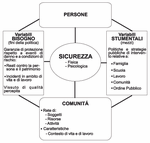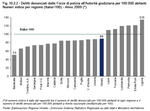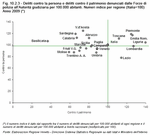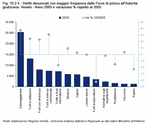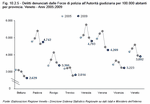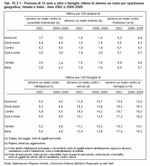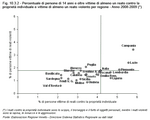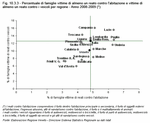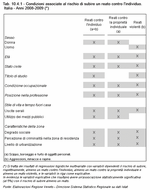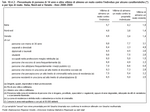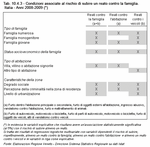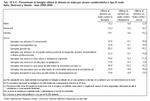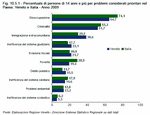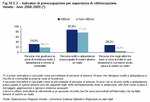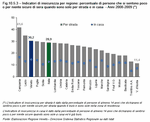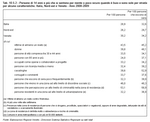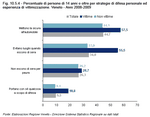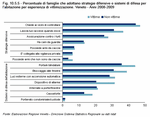-
Statistical departmentís site
Home page
Our publications
Chapter 10
Protecting ourselves from fear (Note 1)
"Protecting ourselves from fear" has always been a basic human need: we fear being a victim of physical and psychological violence, accidents at home and at work, disasters, terrorism, war, the future, and being unable to afford an independent and dignified standard living for ourselves and our loved ones. The seven commandments in the Bible that concern how to behave towards neighbours were not so much restraints as the premises to ensure safety, freedom and justice for all, and respect of others as the basis of communal living.
The right to life is celebrated directly in the Fifth Commandment "Thou shall not kill"; murder is indeed the most serious crime against people. But the seventh "Thou shall not steal" supports the right of the individual to the pursuit of happiness through property. There are many kinds of theft, but all of them are crimes against property and play a part in the safety of the people who live and work in a community.
Safety, freedom and justice are closely linked to one another. "Protecting" quality of life is often given great importance in government development policies and strategies, fundamental human rights charters, and the constitutions of international organisations of democratic countries.
The right to life is celebrated directly in the Fifth Commandment "Thou shall not kill"; murder is indeed the most serious crime against people. But the seventh "Thou shall not steal" supports the right of the individual to the pursuit of happiness through property. There are many kinds of theft, but all of them are crimes against property and play a part in the safety of the people who live and work in a community.
Safety, freedom and justice are closely linked to one another. "Protecting" quality of life is often given great importance in government development policies and strategies, fundamental human rights charters, and the constitutions of international organisations of democratic countries.
The figure below is an attempt to portray the principal phenomena that play a role in public safety. (Figure 10.1.1)
The central nexus of the network summarises the macro phenomenon of safety concerning the physical and psychological state of people in respect to dangers, risk factors and individual lives.
The two nodes on the vertical axis of the central node of the network refer to individuals (above) and communities (below). Individuals are considered in relation to the personal need for safety from physical and psychological violence. The community is a physical and living environment that embodies the phenomena of safety.
The node on the left of the network regards people's "needs for protection" and encompasses the "safety" dimension of quality of life. The node to the right refers to "instrumental" variables, that is to the public measures introduced to maintain and improve the quality of safety within the community over time.
Not all of the safety phenomena in the figure can be included in this report, not even in a general or summarised form. Therefore the content of this chapter concerns a few aspects of the "safety needs" block: crime rate, number of victims, their personal circumstances and perceived quality of life. It concentrates on information regarding final variables, i.e. what governs safety policy, the decisions that are made to improve safety within the community.
Fear of being a victim of crime is one aspect of people's lives that is taking on greater importance in the complex set of factors that make up a community's quality of life. It is a variable that plays a significant role in guaranteeing the sustainability of developmental processes.
It is not easy to take effective and shared actions to fight crime, but it has to be done; the availability of relevant and up-to-date statistical information about the phenomenon is a good place to start and a useful tool for decision-making.
The central nexus of the network summarises the macro phenomenon of safety concerning the physical and psychological state of people in respect to dangers, risk factors and individual lives.
The two nodes on the vertical axis of the central node of the network refer to individuals (above) and communities (below). Individuals are considered in relation to the personal need for safety from physical and psychological violence. The community is a physical and living environment that embodies the phenomena of safety.
The node on the left of the network regards people's "needs for protection" and encompasses the "safety" dimension of quality of life. The node to the right refers to "instrumental" variables, that is to the public measures introduced to maintain and improve the quality of safety within the community over time.
Not all of the safety phenomena in the figure can be included in this report, not even in a general or summarised form. Therefore the content of this chapter concerns a few aspects of the "safety needs" block: crime rate, number of victims, their personal circumstances and perceived quality of life. It concentrates on information regarding final variables, i.e. what governs safety policy, the decisions that are made to improve safety within the community.
Fear of being a victim of crime is one aspect of people's lives that is taking on greater importance in the complex set of factors that make up a community's quality of life. It is a variable that plays a significant role in guaranteeing the sustainability of developmental processes.
It is not easy to take effective and shared actions to fight crime, but it has to be done; the availability of relevant and up-to-date statistical information about the phenomenon is a good place to start and a useful tool for decision-making.
An objective measure of the crime rate is the number of criminal incidents recorded over a given period of time. From an analysis of recorded crime (Note 2) in the period 2005-2009, an increase can be seen in the crime rate until 2007, followed by a rather marked decline, which then diminished further.
In 2009 the crime rate for Italy was 4,369 crimes per 100,000 inhabitants, that is 2,629,831 recorded crimes; in Veneto it was lower: 3,892 per 100,000 inhabitants (190,692 recorded crimes). Compared to the national level, the situation in Veneto seems more favourable, both because recorded crime remains constantly below the national average and because the decline in recorded crime in the region was larger, especially in the last two-year period. (Figure 10.2.1)
By region, Liguria, Emilia Romagna, Piemonte and Lombardia had the highest crime rates, as much as 35% more than the national average. They are regions with a high population density and some of the largest urban centres of Italy, confirming the link between crime rate and urbanisation level.
Veneto, in 14th place, has a higher rate than the regions of the Centre and South, as well as Friuli Venezia Giulia, Trentino Alto Adige and Valle d'Aosta. However, the variation found when comparing regions should be interpreted with caution, because it may not indicate a real difference in the crime rate, but only a different propensity to report crime. The results proposed, in fact, refer only to recorded crime and not all crime; therefore they may underestimate the real extent of the phenomenon, especially in areas where there is a lower propensity to report, especially certain kinds of crime. Lower sense of civic duty and participation, the presence of organised crime or the lack of confidence in the efforts of the police, prosecutors and courts may inhibit willingness to report. (Figure 10.2.2)
The categories of the penal code were used to aggregate the different kinds of crimes in the Ministry of the Interior information system. Two macro-categories were created: "Crimes against the person" and "Crimes against property" (Note 3). The first includes crimes against life, such as mass murder and the various kinds of homicide, and crimes against individual safety and liberty, such as battery, bodily harm, threats, kidnapping, rape and crimes against minors. They made up about 10% of the crimes reported in Veneto in 2009 and the most common of these are threats (3.1% of all crimes reported), verbal abuse (3%) and bodily harm (2.4%). On the other hand, crimes against property, mostly theft, make up more than 70% of the recorded crimes.
These two categories vary in the Italian regions. The graph chosen allows the regions above and below the national average for both macro-categories to be identified immediately. There are few regions that are marked by a crime rate higher than the average for both crimes against the person and against property (the upper right-hand quadrant); the virtuous ones, or at least those less likely to report, are more numerous and found in the lower left-hand quadrant. Lazio stands out for the lowest rate of recorded crime against people, but has widespread crime against property; for Valle d'Aosta the result is the opposite.
Veneto is found among the virtuous regions and the biggest difference from the national average concerns crimes against property, with a rate below 11%. However, there is an exception within this category: although Veneto has the lowest risk of theft of a car or motorcycle, with a rate of about one third of the national average, the risk of being the victim of burglary is higher (266 reported per 100,000 inhabitants compared to 251 for Italy). (Figure 10.2.3)
Going on to examine single crimes, the crime rate in Veneto was lower than the national average for nearly all categories. Ignoring rare crimes, for which comparison is not very significant, a few crimes against the person are exceptions, such as battery and defamation, and, for crimes against property, theft from parked cars, shoplifting and burglary.
For violent crime, the robbery rate is less than half of the corresponding national figure, that is to say 27 per 100,000 inhabitants, as opposed to a national average of nearly 60.
Vandalism was the category of crime most often reported (more than 25,000 in 2009) followed by various kinds of theft, which, if considered as a whole, becomes the most often recorded crime (101,315). (Figure 10.2.4)
Considering the most common crimes, compared to 2005 in Veneto as at national level, crimes against the person grew generally; burglary, shop theft and pickpocketing increased, while car theft declined significantly (-42%).
Rape, in particular, increased by nearly 30% compared to 2005, probably in part due to the greater attention given to it and greater sensitivity of both society and institutions for a problem that very often, out of shame or fear, was not reported, but kept behind closed doors and hidden by the silence of its victims. More than a real increase in the phenomenon, there seems to be a greater willingness of the victims to report it. (Figure 10.2.5)
Within the region there is a degree of variability in the crime rates: the provinces at greatest risk are Venezia, Padova and Verona. The rates recorded in Venezia and Padova are almost 10% above the national average: nearly 4,800 and just over 4,700 crimes per 100,000 inhabitants were reported respectively. Except for Verona, substantially on a par with the national figure, the rates in the other provinces are all lower. Belluno and Treviso have the least crime, 60% and 64% of the national average respectively, that is to say about 2,600 and 2,800 recorded crimes per 100,000 inhabitants respectively.
Concerning the trend in crime, the provincial level experienced an increase in recorded crime in the three-year period from 2005 to 2007, followed by a sharp decline in the following year. Except for Padova and Treviso, 2009 compared to 2008 recorded a further decline, even though much smaller compared to the previous one.
Belluno, the topography of which is unique in the region, contrasts with the other provinces in many ways, including crime. In addition to being the province with the lowest rate, it has particularly low rate of crimes against property compared to a higher number of crimes against the person: while in Veneto on average 10% of recorded crimes were against people, their weight doubles in the province of Belluno.
In 2009 the crime rate for Italy was 4,369 crimes per 100,000 inhabitants, that is 2,629,831 recorded crimes; in Veneto it was lower: 3,892 per 100,000 inhabitants (190,692 recorded crimes). Compared to the national level, the situation in Veneto seems more favourable, both because recorded crime remains constantly below the national average and because the decline in recorded crime in the region was larger, especially in the last two-year period. (Figure 10.2.1)
By region, Liguria, Emilia Romagna, Piemonte and Lombardia had the highest crime rates, as much as 35% more than the national average. They are regions with a high population density and some of the largest urban centres of Italy, confirming the link between crime rate and urbanisation level.
Veneto, in 14th place, has a higher rate than the regions of the Centre and South, as well as Friuli Venezia Giulia, Trentino Alto Adige and Valle d'Aosta. However, the variation found when comparing regions should be interpreted with caution, because it may not indicate a real difference in the crime rate, but only a different propensity to report crime. The results proposed, in fact, refer only to recorded crime and not all crime; therefore they may underestimate the real extent of the phenomenon, especially in areas where there is a lower propensity to report, especially certain kinds of crime. Lower sense of civic duty and participation, the presence of organised crime or the lack of confidence in the efforts of the police, prosecutors and courts may inhibit willingness to report. (Figure 10.2.2)
The categories of the penal code were used to aggregate the different kinds of crimes in the Ministry of the Interior information system. Two macro-categories were created: "Crimes against the person" and "Crimes against property" (Note 3). The first includes crimes against life, such as mass murder and the various kinds of homicide, and crimes against individual safety and liberty, such as battery, bodily harm, threats, kidnapping, rape and crimes against minors. They made up about 10% of the crimes reported in Veneto in 2009 and the most common of these are threats (3.1% of all crimes reported), verbal abuse (3%) and bodily harm (2.4%). On the other hand, crimes against property, mostly theft, make up more than 70% of the recorded crimes.
These two categories vary in the Italian regions. The graph chosen allows the regions above and below the national average for both macro-categories to be identified immediately. There are few regions that are marked by a crime rate higher than the average for both crimes against the person and against property (the upper right-hand quadrant); the virtuous ones, or at least those less likely to report, are more numerous and found in the lower left-hand quadrant. Lazio stands out for the lowest rate of recorded crime against people, but has widespread crime against property; for Valle d'Aosta the result is the opposite.
Veneto is found among the virtuous regions and the biggest difference from the national average concerns crimes against property, with a rate below 11%. However, there is an exception within this category: although Veneto has the lowest risk of theft of a car or motorcycle, with a rate of about one third of the national average, the risk of being the victim of burglary is higher (266 reported per 100,000 inhabitants compared to 251 for Italy). (Figure 10.2.3)
Going on to examine single crimes, the crime rate in Veneto was lower than the national average for nearly all categories. Ignoring rare crimes, for which comparison is not very significant, a few crimes against the person are exceptions, such as battery and defamation, and, for crimes against property, theft from parked cars, shoplifting and burglary.
For violent crime, the robbery rate is less than half of the corresponding national figure, that is to say 27 per 100,000 inhabitants, as opposed to a national average of nearly 60.
Vandalism was the category of crime most often reported (more than 25,000 in 2009) followed by various kinds of theft, which, if considered as a whole, becomes the most often recorded crime (101,315). (Figure 10.2.4)
Considering the most common crimes, compared to 2005 in Veneto as at national level, crimes against the person grew generally; burglary, shop theft and pickpocketing increased, while car theft declined significantly (-42%).
Rape, in particular, increased by nearly 30% compared to 2005, probably in part due to the greater attention given to it and greater sensitivity of both society and institutions for a problem that very often, out of shame or fear, was not reported, but kept behind closed doors and hidden by the silence of its victims. More than a real increase in the phenomenon, there seems to be a greater willingness of the victims to report it. (Figure 10.2.5)
Within the region there is a degree of variability in the crime rates: the provinces at greatest risk are Venezia, Padova and Verona. The rates recorded in Venezia and Padova are almost 10% above the national average: nearly 4,800 and just over 4,700 crimes per 100,000 inhabitants were reported respectively. Except for Verona, substantially on a par with the national figure, the rates in the other provinces are all lower. Belluno and Treviso have the least crime, 60% and 64% of the national average respectively, that is to say about 2,600 and 2,800 recorded crimes per 100,000 inhabitants respectively.
Concerning the trend in crime, the provincial level experienced an increase in recorded crime in the three-year period from 2005 to 2007, followed by a sharp decline in the following year. Except for Padova and Treviso, 2009 compared to 2008 recorded a further decline, even though much smaller compared to the previous one.
Belluno, the topography of which is unique in the region, contrasts with the other provinces in many ways, including crime. In addition to being the province with the lowest rate, it has particularly low rate of crimes against property compared to a higher number of crimes against the person: while in Veneto on average 10% of recorded crimes were against people, their weight doubles in the province of Belluno.
In addition to the crime rate, it is important to know how many victims there are and to be able to profile them based on their personal, family and social characteristics and any other risk factors, in order to better manage community safety policy.
The data on recorded crime from the Ministry of the Interior does not allow this kind of information to be extracted. A supplement that partially fills the gap is furnished by the study on citizen safety (Note 4) carried out at family level by Italy's National Institute of Statistics (ISTAT). It intended to investigate victimisation in Italy, if people had one or more crimes committed against them and what kind, perceived safety and how fear of being a victim of crime has a negative impact on the quality of life, limiting tranquillity and freedom to the point that people change their everyday behaviour and habits. The study has made it possible to explore crime from the point of view of its victims; since it is based on personal interviews with families, it has the strength of bringing to light hidden crime, that is those crimes that are not reported by victims to the authorities.
However, even the results gathered in this manner do not represent a precise measure of the crime level. The answers of the participants may be distorted or contain mistakes, even if involuntarily. This is mainly because of a reluctance to talk about their experience as victims, especially for certain kinds of crime, and this leads to errors due to faulty memory or an altered perception of the event. For all of these reasons, the results of this analysis do not always coincide with those from the authorities, such as the Ministry of the Interior figures on recorded crime discussed above.
Numerous crime indicators can be extracted from victim data; below particular attention is given to indices of frequency, that is to say the percentage of victims in the population based on crimes committed in the twelve months before the interview. As regards the kinds of crime studied, it distinguishes between violent crime against individuals and that against families; in the latter case, the person interviewed spoke in the name of his/her family about acts that involved other family members.
Crimes against individuals include bag-snatching, pickpocketing and theft of personal possessions, below defined as crimes against property, and violent crimes, that is robbery, threats and assaults. Cases of rape, however, are not included, as the seriousness of the crime, the kind of violence and the context in which it occurs would require specific study. At family level, the crimes were predominantly damage and theft from homes and motor vehicles (Note 5).
In 2008-2009, 5.7% of the Italian population aged 14 years and over declared they had been a victim of at least one incident of bag-snatching, pickpocketing, and theft of personal possessions, or of a violent crime, such as robbery, threats and assaults, in the 12 months before the interview. If crimes against the family are considered, on average there are 16 victims per 100 inhabitants.
At regional level, Veneto is ranked in the middle, with 4.6% of individuals being victims and 14.1% of families, both values below the national average. The rankings again indicate the regions with the largest cities as the ones with the highest levels of crime, while Valle d'Aosta ranks first among the regions with the lowest percentage of victims. (Figure 10.3.1)
In comparison with 2002 (Note 6), the percentage of victims remains basically constant for crimes against individuals, while a clear decline in crimes against families was recorded. The families who were victims of crimes against their homes decreased, especially in the North West and in the South, while those reporting crimes against vehicles declined in the North East as well. Even though in decline, the percentage in the Central regions remained above the Italian average for all kinds of crime against families.
Veneto is not significantly different from the situation in the North East, for both the level of victims and for the size of the variation over the time periods examined. The highest victimisation rates for families can be attributed primarily to crimes involving vehicles: although 10% of Veneto families declare they have been victim of at least one crime of this kind, the percentage is cut in half for crimes against their homes. At individual level, victimisation most often involves crimes against property rather than violent crime: while the latter affect 1.4% of the Veneto population aged 14 years or older, the former involve 3.4 people per 100 inhabitants. (Table 10.3.1)
Compared to the results derived from crimes reported by the police to the courts, the analysis based on victim statements paints a slightly different picture of Italy's regions; for example, it resizes the position of Emilia Romagna, Piemonte and Toscana, which have among the highest rates of recorded crimes, viceversa for the risk of victimisation in the regions of Lazio and, especially, Campania. On the other hand, there is a higher tendency to report crime in the North than in the South and the amount of hidden crime varies greatly according to the kind and outcome of the crime. The hidden number of crimes is greater for street crime, such as pickpocketing, bag-snatching or theft of personal possessions and bicycles, and is particularly high for rape; on the other hand it is lower, perhaps inexistent, for more serious or heinous crimes and for those in which a report is necessary to make an insurance claim, such as theft from flats or of vehicles.
The reasons which influence the propensity to report are varied. In addition to the seriousness of the crime and the economic or physical damage suffered, certainly citizens also evaluate the direct or indirect consequences to which they think they are exposed when they decide to report a crime, and this also has an effect. For example, the rapport between the public and the authorities, and confidence in the public safety system both have an influence.
For Veneto, what emerges from the analysis of the ISTAT victimisation study does not seem to be too far from what is found from the crimes reported to the Ministry of the Interior. (Figure 10.3.2) and (Figure 10.3.3)
The ISTAT study on families also provides estimates for the frequency of both forms of crime, because the victims were asked to distinguish between committed and attempted crime. This distinction is clearly admissible only for some crimes, i.e. all of those against personal property and robberies (Note 7), as well as theft from homes and vehicles, for which the thief was unable to obtain the things he/she intended to steal. It makes no sense to talk about attempted crimes involving threats, assault, acts of vandalism and unlawful entry into homes. (Table 10.3.2)
The relationship between committed crimes and the total of recorded crime, both committed and attempted, determines the probability of "success" for those that commit crime. Overall, committed crimes are the majority, even though the probability of success varies according to the kind of crime. It is highest for crimes against personal property and declines with the seriousness of the crime, with the involvement of the victim and, obviously, the precautions made to protect property. It varies greatly geographically, especially for burglary and vehicle theft. The latter is successful only in one out of two cases in the South and the Islands and nearly three out of four cases in the North East. These differences, in any case, should not be attributed to the greater or lesser ability of victims to defend themselves; if it is kept in mind that the estimates derive from the interviewees' answers, some people are prone to report only committed crimes, willingly leaving aside attempted crime because they did not have serious consequences.
Keeping these considerations in mind, it is observed that in Veneto the probability of success is very high both for vehicle theft and for property crime, whilst, on the other hand, it is among the lowest for burglary.
In Veneto, in a relatively short period of time, 23% of the victims say they have suffered more than one crime against people, that is 10 people per 1,000 inhabitants, and they are the victims of nearly half of all criminal acts.
Generally, where crime is more widespread in terms of frequency, that is to say as a percentage of victims in the population, the level of multiple victimisation is even greater, and among the regions it varies from a 9% low in Umbria to a 30% high in Lazio, where therefore nearly one third of all victims have experienced more than one criminal act.
Multiple victimisation is even more troubling if we consider that it occurs more frequently, nearly twice as often, for violent crimes compared to property crimes. In Italy, for example, 42.3% of the victims of threats are repeat victims, whilst the corresponding figure for all crimes is 23.6%. (Table 10.3.4)
The phenomenon is greater for crimes against the family, with it striking 63 families per 1,000 and 39% of victims. In Veneto the share of multiple victimisation, that is of more frequently targeted families, is equal to 28.5% of victims, the second lowest value after Valle d'Aosta, and well short of that recorded for the rest of Italy, especially in the Southern regions. Furthermore, although at national level more repeat crimes are committed against vehicles than against homes, in Veneto there is no significant difference between the two.
For crimes against homes, several characteristics of the housing itself are significant, especially those that reflect the wealth of the family and that, therefore, may be more attractive to people with bad intentions; for crimes against vehicles, the number of cars, motorcycles and bicycles owned by the family has a clear influence on multiple victimisation.
The data on recorded crime from the Ministry of the Interior does not allow this kind of information to be extracted. A supplement that partially fills the gap is furnished by the study on citizen safety (Note 4) carried out at family level by Italy's National Institute of Statistics (ISTAT). It intended to investigate victimisation in Italy, if people had one or more crimes committed against them and what kind, perceived safety and how fear of being a victim of crime has a negative impact on the quality of life, limiting tranquillity and freedom to the point that people change their everyday behaviour and habits. The study has made it possible to explore crime from the point of view of its victims; since it is based on personal interviews with families, it has the strength of bringing to light hidden crime, that is those crimes that are not reported by victims to the authorities.
However, even the results gathered in this manner do not represent a precise measure of the crime level. The answers of the participants may be distorted or contain mistakes, even if involuntarily. This is mainly because of a reluctance to talk about their experience as victims, especially for certain kinds of crime, and this leads to errors due to faulty memory or an altered perception of the event. For all of these reasons, the results of this analysis do not always coincide with those from the authorities, such as the Ministry of the Interior figures on recorded crime discussed above.
Numerous crime indicators can be extracted from victim data; below particular attention is given to indices of frequency, that is to say the percentage of victims in the population based on crimes committed in the twelve months before the interview. As regards the kinds of crime studied, it distinguishes between violent crime against individuals and that against families; in the latter case, the person interviewed spoke in the name of his/her family about acts that involved other family members.
Crimes against individuals include bag-snatching, pickpocketing and theft of personal possessions, below defined as crimes against property, and violent crimes, that is robbery, threats and assaults. Cases of rape, however, are not included, as the seriousness of the crime, the kind of violence and the context in which it occurs would require specific study. At family level, the crimes were predominantly damage and theft from homes and motor vehicles (Note 5).
In 2008-2009, 5.7% of the Italian population aged 14 years and over declared they had been a victim of at least one incident of bag-snatching, pickpocketing, and theft of personal possessions, or of a violent crime, such as robbery, threats and assaults, in the 12 months before the interview. If crimes against the family are considered, on average there are 16 victims per 100 inhabitants.
At regional level, Veneto is ranked in the middle, with 4.6% of individuals being victims and 14.1% of families, both values below the national average. The rankings again indicate the regions with the largest cities as the ones with the highest levels of crime, while Valle d'Aosta ranks first among the regions with the lowest percentage of victims. (Figure 10.3.1)
In comparison with 2002 (Note 6), the percentage of victims remains basically constant for crimes against individuals, while a clear decline in crimes against families was recorded. The families who were victims of crimes against their homes decreased, especially in the North West and in the South, while those reporting crimes against vehicles declined in the North East as well. Even though in decline, the percentage in the Central regions remained above the Italian average for all kinds of crime against families.
Veneto is not significantly different from the situation in the North East, for both the level of victims and for the size of the variation over the time periods examined. The highest victimisation rates for families can be attributed primarily to crimes involving vehicles: although 10% of Veneto families declare they have been victim of at least one crime of this kind, the percentage is cut in half for crimes against their homes. At individual level, victimisation most often involves crimes against property rather than violent crime: while the latter affect 1.4% of the Veneto population aged 14 years or older, the former involve 3.4 people per 100 inhabitants. (Table 10.3.1)
Compared to the results derived from crimes reported by the police to the courts, the analysis based on victim statements paints a slightly different picture of Italy's regions; for example, it resizes the position of Emilia Romagna, Piemonte and Toscana, which have among the highest rates of recorded crimes, viceversa for the risk of victimisation in the regions of Lazio and, especially, Campania. On the other hand, there is a higher tendency to report crime in the North than in the South and the amount of hidden crime varies greatly according to the kind and outcome of the crime. The hidden number of crimes is greater for street crime, such as pickpocketing, bag-snatching or theft of personal possessions and bicycles, and is particularly high for rape; on the other hand it is lower, perhaps inexistent, for more serious or heinous crimes and for those in which a report is necessary to make an insurance claim, such as theft from flats or of vehicles.
The reasons which influence the propensity to report are varied. In addition to the seriousness of the crime and the economic or physical damage suffered, certainly citizens also evaluate the direct or indirect consequences to which they think they are exposed when they decide to report a crime, and this also has an effect. For example, the rapport between the public and the authorities, and confidence in the public safety system both have an influence.
For Veneto, what emerges from the analysis of the ISTAT victimisation study does not seem to be too far from what is found from the crimes reported to the Ministry of the Interior. (Figure 10.3.2) and (Figure 10.3.3)
The outcome of crimes
Generally, committed crimes, that is according to the penal code, the criminal act in which the perpetrator was able to achieve the intended result, are reported more often than those merely attempted. Attempted crimes, even if slight, can still have negative consequences for victims, undermining their psychological state and feeding their fears and sense of insecurity.The ISTAT study on families also provides estimates for the frequency of both forms of crime, because the victims were asked to distinguish between committed and attempted crime. This distinction is clearly admissible only for some crimes, i.e. all of those against personal property and robberies (Note 7), as well as theft from homes and vehicles, for which the thief was unable to obtain the things he/she intended to steal. It makes no sense to talk about attempted crimes involving threats, assault, acts of vandalism and unlawful entry into homes. (Table 10.3.2)
The relationship between committed crimes and the total of recorded crime, both committed and attempted, determines the probability of "success" for those that commit crime. Overall, committed crimes are the majority, even though the probability of success varies according to the kind of crime. It is highest for crimes against personal property and declines with the seriousness of the crime, with the involvement of the victim and, obviously, the precautions made to protect property. It varies greatly geographically, especially for burglary and vehicle theft. The latter is successful only in one out of two cases in the South and the Islands and nearly three out of four cases in the North East. These differences, in any case, should not be attributed to the greater or lesser ability of victims to defend themselves; if it is kept in mind that the estimates derive from the interviewees' answers, some people are prone to report only committed crimes, willingly leaving aside attempted crime because they did not have serious consequences.
Keeping these considerations in mind, it is observed that in Veneto the probability of success is very high both for vehicle theft and for property crime, whilst, on the other hand, it is among the lowest for burglary.
Multiple victimisation (Note 8)
A particularly serious and worrying aspect is crime being repeatedly committed against the same victim. Again thanks to the victimisation studies, it is possible to uncover that a large part of crime is concentrated on a rather small number of victims; in fact there is a part of the population that is particularly fragile that seems to be exposed to the risk of being a repeat victim of the same crime or a variety of crimes. (Table 10.3.3)In Veneto, in a relatively short period of time, 23% of the victims say they have suffered more than one crime against people, that is 10 people per 1,000 inhabitants, and they are the victims of nearly half of all criminal acts.
Generally, where crime is more widespread in terms of frequency, that is to say as a percentage of victims in the population, the level of multiple victimisation is even greater, and among the regions it varies from a 9% low in Umbria to a 30% high in Lazio, where therefore nearly one third of all victims have experienced more than one criminal act.
Multiple victimisation is even more troubling if we consider that it occurs more frequently, nearly twice as often, for violent crimes compared to property crimes. In Italy, for example, 42.3% of the victims of threats are repeat victims, whilst the corresponding figure for all crimes is 23.6%. (Table 10.3.4)
The phenomenon is greater for crimes against the family, with it striking 63 families per 1,000 and 39% of victims. In Veneto the share of multiple victimisation, that is of more frequently targeted families, is equal to 28.5% of victims, the second lowest value after Valle d'Aosta, and well short of that recorded for the rest of Italy, especially in the Southern regions. Furthermore, although at national level more repeat crimes are committed against vehicles than against homes, in Veneto there is no significant difference between the two.
For crimes against homes, several characteristics of the housing itself are significant, especially those that reflect the wealth of the family and that, therefore, may be more attractive to people with bad intentions; for crimes against vehicles, the number of cars, motorcycles and bicycles owned by the family has a clear influence on multiple victimisation.
In order to reduce the crime level, it is necessary to intervene not only after the fact with reparative measures, but also before the fact with preventative measures, both against potential criminals and against risk factors to which victims are exposed. The preventative approach focuses especially on individual behaviour and on the social and environmental opportunities that favour crime in order to make individuals more responsible, so that their negligence does not make them easy prey of a delinquent, while being more careful may keep them out of harm's way.
Victimology theory holds that the probability of being a victim is not equally distributed among all persons. Except for cases in which the victim's behaviour induces a criminal act, for example a physical or verbal provocation versus the aggressor, three circumstances favour the probability of victimisation. Victims find themselves, knowingly or unknowingly, in a risky situation or environment, for example in a dark or dangerous street, or flaunting something that attracts the attention of criminals, such as money or valuables; finally, a person may be particularly vulnerable due to their physical characteristics, socio-economic status or way of life.
With reference to literature and data analysis on victimisation in Italy and Veneto, we have attempted to establish the validity of the link between risk and certain victim characteristics. This is a preliminary analysis, one certainly in need of further exploration, but it is a good start on identifying some higher risk groups.
In order to profile the victims, several individual characteristics were considered, such as general and socio-economic characteristics, as well as behaviour and lifestyle, such as the tendency to go out during the day or the evening, and frequent use of public transport, which could be places of greater risk. This is combined with the area of residence, i.e. if people live in a highly urbanised, rundown area, in which there is vandalism, or one characterised by social disorder, such as the presence of vagrants, drug addicts, drug-dealers or prostitutes. Also the lack of adequate monitoring by the police in the area of residence may increase the risk of victimisation. In addition, for crimes against the family, the type of family and housing, as an additional indicator of economic wellbeing, has also been considered.
Since various weaknesses occur in the same individual, so various risk factors may together affect the likelihood of victimisation. To profile the victims a multivariate statistical analysis was carried out (Note 9); this has the advantage of isolating the association between specific conditions and the risk of being a victim, net of other factors.
As victimisation data is based on samples, the multivariate analysis for Veneto does not yield statistical estimates that are sufficiently trustworthy, so the analysis refers to the population of Italy as a whole. For Veneto, however, the rate of victims of a specific nature is reported (Note 10), even though it is known that we are dealing with a spurious measure of correlation, as it includes a range of other factors.
The tables below show the results of the multivariate analysis carried out on a national scale. The variables that have a statistically significant link with the risk of victimisation are highlighted in grey; for each of these variables we then give the percentage of victims in Veneto for the categories most at risk.
Age is the variable most highly associated with the risk of victimisation: the risk declines noticeably as people grow older and reaches a low point for those over 65, especially for violent crime. This surely depends on lifestyle: the elderly, indeed, even though vulnerable, encounter certain situations of risk less often. The most exposed are young people under 30, for whom the risk is more than double what it is for the elderly. In Veneto, nearly 10% of victims are young people compared to 4.6% of the population as a whole.
To profile the victims, it is therefore important to consider lifestyle and behaviour. The risk of victimisation rises for those who are often outside the home, especially at night: 6.8% of those who often go out at night are victims at least once, as are 7% of those who often use public transport; the latter are most often victims of pickpocketing and theft. Lifestyle also helps to explain the differences that are found according to marital status: people who are separated and divorced are more at risk; on the contrary married housewives and widows are less exposed to situations of risk.
Socio-economic status is measured through education level and occupation, since income is not available. People who are well-off financially, better educated and highly paid are more exposed to risk.
The link between surroundings and victimisation emerges in the differences that are observed between those who live in more or less urbanised areas, in dilapidated neighbourhoods, or where there is social disorder. In Veneto, 6.5% of the people that live in highly urbanised municipalities, generally provincial capitals, said they had been victim of at least one crime in the last 12 months, a figure that is halved for those who live in municipalities with less than 10,000 inhabitants. It is also true that various forms of social disorder and marginalisation tend to be concentrated in large cities and their suburbs; considering some of the features of social disorder, such as prostitutes, drug users and dealers, dilapidation and vandalism, the number of victims among those who live in these areas reaches 9.3%, about double the average number for the whole region.
The crime level in an area of residence is clearly significant. On this question, the only information available in the study refers to how people evaluate crime in their area, here used, with due caution, as a proxy for the level of crime. According to the study, 7.5 victims per 100 people think their neighbourhood is dangerous and 6.4 think the work of the police is inadequate and unable to control the risk of crime in the area. It is without doubt also the result of victimisation itself, which induces the victims of recent crime to overestimate the risk and to think that the efforts of the police who failed to prevent the crime to be less than efficient. (Table 10.4.1) and (Table 10.4.2)
As for crimes against individuals, age was a decisive variable for the risk of victimisation, and for the youngest families the figure reached 20%. A greater risk was also found for particular kinds of families, for example single-parent and large families. Although, on the one hand the larger the family the more goods will be available, on the other large families leave their homes empty less often than single-person families do; an exception is made for the elderly, who have a lifestyle that is mostly home-centred. The greatest vulnerability of large families, thus, is found not to be against their home, but rather against their vehicles precisely because they own more.
Confirming the importance of social class, the risk of victimisation increases significantly in the families in which at least one member has a well-paid job, whether as an executive, an entrepreneur or a professional, and for those who live in more luxurious homes. The characteristics of the home are a proxy for wealth and clearly the more luxurious the home the more attractive it is in the eyes of thieves, who expect a large haul. And, in fact, detached houses, large and small, and luxury apartments are the kinds of homes most visited by burglars.
The multivariate analysis of Italy suggests that exposure to risk of vehicle crime increases for those who live in modest homes (Note 11). Similar results obtained in other studies have been attributed to the fact that private houses and apartments have garages and private car parks less often, especially in large cities. This is not what was found in Veneto, perhaps because of its lower level of urbanisation and the larger number of private garages: 81.3% of homes have a garage or a covered parking space compared to the national average of 55% (Note 12).
The degree of urbanisation may be an important element in the link with risk of victimisation, according to the kind of crime. Car, motorcycle, bicycle and vehicle thefts in general are more frequent in metropolitan and more densely populated areas because they are more numerous and are left unattended more often. The risk of theft in the home, instead, is the same for those who live in highly urbanised areas and for those who live in small villages and rural areas.
The network of social relations that a family creates around itself is an effective element of protection; and indeed transient people are at greater risk, both those who often travel and change area of residence, not only because they are less aware of the dangers, but also because they are less protected by the inclusive system of neighbours, friends and acquaintances (Note 13).
Social disorder in an area of residence completes the picture: 25.5% of the families that live in dilapidated neighbourhoods and 23.6% of those who see their own neighbourhood to be dangerous are victims of at least one crime. (Table 10.4.3) and (Table 10.4.4)
Victimology theory holds that the probability of being a victim is not equally distributed among all persons. Except for cases in which the victim's behaviour induces a criminal act, for example a physical or verbal provocation versus the aggressor, three circumstances favour the probability of victimisation. Victims find themselves, knowingly or unknowingly, in a risky situation or environment, for example in a dark or dangerous street, or flaunting something that attracts the attention of criminals, such as money or valuables; finally, a person may be particularly vulnerable due to their physical characteristics, socio-economic status or way of life.
With reference to literature and data analysis on victimisation in Italy and Veneto, we have attempted to establish the validity of the link between risk and certain victim characteristics. This is a preliminary analysis, one certainly in need of further exploration, but it is a good start on identifying some higher risk groups.
In order to profile the victims, several individual characteristics were considered, such as general and socio-economic characteristics, as well as behaviour and lifestyle, such as the tendency to go out during the day or the evening, and frequent use of public transport, which could be places of greater risk. This is combined with the area of residence, i.e. if people live in a highly urbanised, rundown area, in which there is vandalism, or one characterised by social disorder, such as the presence of vagrants, drug addicts, drug-dealers or prostitutes. Also the lack of adequate monitoring by the police in the area of residence may increase the risk of victimisation. In addition, for crimes against the family, the type of family and housing, as an additional indicator of economic wellbeing, has also been considered.
Since various weaknesses occur in the same individual, so various risk factors may together affect the likelihood of victimisation. To profile the victims a multivariate statistical analysis was carried out (Note 9); this has the advantage of isolating the association between specific conditions and the risk of being a victim, net of other factors.
As victimisation data is based on samples, the multivariate analysis for Veneto does not yield statistical estimates that are sufficiently trustworthy, so the analysis refers to the population of Italy as a whole. For Veneto, however, the rate of victims of a specific nature is reported (Note 10), even though it is known that we are dealing with a spurious measure of correlation, as it includes a range of other factors.
The tables below show the results of the multivariate analysis carried out on a national scale. The variables that have a statistically significant link with the risk of victimisation are highlighted in grey; for each of these variables we then give the percentage of victims in Veneto for the categories most at risk.
Who the victims are
According to the results of the multivariate analysis, the risk of victimisation is different for men and women. Gender differences were found in the type of crime: men are more often involved in violent crime, especially robbery and assault, while women are more likely to be victims of bag-snatching and pickpocketing. The difference for theft of personal possessions in which there is no contact between the criminal and the victim is smaller.Age is the variable most highly associated with the risk of victimisation: the risk declines noticeably as people grow older and reaches a low point for those over 65, especially for violent crime. This surely depends on lifestyle: the elderly, indeed, even though vulnerable, encounter certain situations of risk less often. The most exposed are young people under 30, for whom the risk is more than double what it is for the elderly. In Veneto, nearly 10% of victims are young people compared to 4.6% of the population as a whole.
To profile the victims, it is therefore important to consider lifestyle and behaviour. The risk of victimisation rises for those who are often outside the home, especially at night: 6.8% of those who often go out at night are victims at least once, as are 7% of those who often use public transport; the latter are most often victims of pickpocketing and theft. Lifestyle also helps to explain the differences that are found according to marital status: people who are separated and divorced are more at risk; on the contrary married housewives and widows are less exposed to situations of risk.
Socio-economic status is measured through education level and occupation, since income is not available. People who are well-off financially, better educated and highly paid are more exposed to risk.
The link between surroundings and victimisation emerges in the differences that are observed between those who live in more or less urbanised areas, in dilapidated neighbourhoods, or where there is social disorder. In Veneto, 6.5% of the people that live in highly urbanised municipalities, generally provincial capitals, said they had been victim of at least one crime in the last 12 months, a figure that is halved for those who live in municipalities with less than 10,000 inhabitants. It is also true that various forms of social disorder and marginalisation tend to be concentrated in large cities and their suburbs; considering some of the features of social disorder, such as prostitutes, drug users and dealers, dilapidation and vandalism, the number of victims among those who live in these areas reaches 9.3%, about double the average number for the whole region.
The crime level in an area of residence is clearly significant. On this question, the only information available in the study refers to how people evaluate crime in their area, here used, with due caution, as a proxy for the level of crime. According to the study, 7.5 victims per 100 people think their neighbourhood is dangerous and 6.4 think the work of the police is inadequate and unable to control the risk of crime in the area. It is without doubt also the result of victimisation itself, which induces the victims of recent crime to overestimate the risk and to think that the efforts of the police who failed to prevent the crime to be less than efficient. (Table 10.4.1) and (Table 10.4.2)
The families most at risk
What has been said about crimes against the person concerning the importance of socio-demographic characteristics and behaviours holds substantially for families as well. In Veneto, 14.1% of families were victims of at least one crime, but the risk is not distributed uniformly and varies according to the characteristics of the family and the kind of crime.As for crimes against individuals, age was a decisive variable for the risk of victimisation, and for the youngest families the figure reached 20%. A greater risk was also found for particular kinds of families, for example single-parent and large families. Although, on the one hand the larger the family the more goods will be available, on the other large families leave their homes empty less often than single-person families do; an exception is made for the elderly, who have a lifestyle that is mostly home-centred. The greatest vulnerability of large families, thus, is found not to be against their home, but rather against their vehicles precisely because they own more.
Confirming the importance of social class, the risk of victimisation increases significantly in the families in which at least one member has a well-paid job, whether as an executive, an entrepreneur or a professional, and for those who live in more luxurious homes. The characteristics of the home are a proxy for wealth and clearly the more luxurious the home the more attractive it is in the eyes of thieves, who expect a large haul. And, in fact, detached houses, large and small, and luxury apartments are the kinds of homes most visited by burglars.
The multivariate analysis of Italy suggests that exposure to risk of vehicle crime increases for those who live in modest homes (Note 11). Similar results obtained in other studies have been attributed to the fact that private houses and apartments have garages and private car parks less often, especially in large cities. This is not what was found in Veneto, perhaps because of its lower level of urbanisation and the larger number of private garages: 81.3% of homes have a garage or a covered parking space compared to the national average of 55% (Note 12).
The degree of urbanisation may be an important element in the link with risk of victimisation, according to the kind of crime. Car, motorcycle, bicycle and vehicle thefts in general are more frequent in metropolitan and more densely populated areas because they are more numerous and are left unattended more often. The risk of theft in the home, instead, is the same for those who live in highly urbanised areas and for those who live in small villages and rural areas.
The network of social relations that a family creates around itself is an effective element of protection; and indeed transient people are at greater risk, both those who often travel and change area of residence, not only because they are less aware of the dangers, but also because they are less protected by the inclusive system of neighbours, friends and acquaintances (Note 13).
Social disorder in an area of residence completes the picture: 25.5% of the families that live in dilapidated neighbourhoods and 23.6% of those who see their own neighbourhood to be dangerous are victims of at least one crime. (Table 10.4.3) and (Table 10.4.4)
Exploring crime also means studying how people perceive it, whether they consider it a serious problem or not, and if so, the degree to which they feel threatened, that is how much the fear of being a victim negatively affects the quality of their lives.
There are close ties between liberty and safety, and fear, if it becomes exasperated, can lead to giving up the former in favour of the latter; it can influence behaviour and lifestyle and accentuate mistrust of others, threatening both individual and collective wellbeing.
Worries about crime are not always justified by an increase in incidents and may not be a real measure of rates. Indeed, it is a perception of one's own experience, what one sees and feels, a judgement that certainly is influenced to a degree by how and with what emphasis the media treat the news. It is an emotional response and worries about crime often come together with fears and suspicions of other problems of social order. (Figure 10.5.1)
In 2009, 51.7% of people in Veneto and 55.3% of Italians said they were worried about the level of crime in the country, so much so it is one of their primary concerns, second only to unemployment. In comparison to the previous year the concern is decreasing.
When people are asked generally what are the most important problems for the country there is an attempt to measure what is defined as "social concern", a form of concern that is affected by how people interpret the news, integrating it coherently with their social and cultural background, their lifestyle and the sources they have access to. It is interesting to note that the problems closest to everyday life, the ones that most often influence people's quality of life, such as pollution, traffic and the lack of public services, are not very important as social problems: for example, only 15% of people complain about the inefficiency of the healthcare system, 13% about the environment, and 5% about the failures of the school system.
Social concern is substantially an indicator of abstract fear which, not being directly connected with personal experience and context, contains little fear of being a real crime victim. In order to better define the perception of risk of crime in daily life, other indicators closer to people's lives are used: whether they think they live in an area highly exposed to crime; whether they fear being the victim of a crime; or whether they have recently been in situations of real danger. (Table 10.5.1)
When they think of the areas in which they live, people tend to become more realistic about their concerns: the neighbourhood in which one lives is thought to be at risk of crime by 2 out of 10 people in Veneto, a limited share of the population and substantially stable over time. On this level, the perception of crime depends on many external factors, such as urban disorder that can be interpreted by people as a tangible sign of the presence or increase in crime.
The perception increases if one thinks of the real risk of being a crime victim: nearly 80% of people said they were worried about home burglaries or motor vehicle thefts or were afraid of being the victim of violent crimes ranging from bag-snatching and pickpocketing to assault, robbery or rape. These indicators are greatly affected by the victimisation of others, especially acquaintances or people who live in the same area, while the percentage who say they have been in such a situation, so that they thought they were about to become a victim (6% in Veneto), refers exclusively to recent personal experience.
On every level, the concern is higher obviously among the victims themselves because the trauma of the crime often does not end with the criminal act, but is protracted over time, creating fear and leading them to perceive a greater risk of crime for themselves and others. (Figure 10.5.2)
Total elimination of fear, other than being impossible, is undesirable since within certain limits it has a positive function and protects us from danger, leading us to be more careful and to take defensive measures. However, if it goes too far, it can lead to phobias or excessive anxiety that may cause irrational and paralysing behaviour that reduces opportunities, whereby we decide not to do things and miss chances for social and intellectual enrichment. It is important that the social emotion of fear remains prudence and does not become a phobia that restricts our daily lives.
Measuring fear is not easy: in investigating victimisation at international level, one of the questions asked is "How safe do you feel alone on a dark street at night in the area in which you live?": an attempt to understand feeling unsafe connected to direct experience. In any case the question is still much criticised and its formulation is not completely accepted due to the use of "dark", "night", "alone", which together may cause fear, especially for some people; this may lead to an overestimate of the perceived lack of safety, even when there is no reasonable risk.
The ISTAT study combines the above question with a similar one on how safe a person feels when home alone at night. (Figure 10.5.3)
Even though the majority of people in Veneto feel basically safe, a significant number of people, 30%, are afraid to go out alone after dark and 15% to be home alone.
For the perception of feeling unsafe, Veneto is a special case with figures that are higher than the national average and those for the North East; indeed, its figures are closer to those observed in several regions in Central and Southern Italy. Moreover, unlike at national level, over time the sense of feeling unsafe has increased, especially fear when alone on the street at night: 26 out 100 people in Veneto did not feel safe between 1997 and 1998, and 28 in 2002.
Victimisation contributes to creating insecurity, and victims are the most frightened; this is a result that seems obvious but it has its importance, since it confirms that generally fear is a reasonable feeling and not an irrational and unjustified reaction. For example, 44% of the people who have had a bag snatched, been pickpocketed or assaulted on the street no longer feel safe going out at night, while it is 30% among non-victims.
In addition, feeling unsafe does not depend only on the probability of being a victim, but also on the vulnerability of the individual: those who are weaker, such as women and the elderly, and therefore more at risk, are more afraid; however married people are also worried, not only for themselves but also for their family members because they feel responsible for their children's safety.
20% of women are afraid to be home alone and nearly 40% to be alone on the street after dark; often this greater fear derives from fear of being assaulted or raped.
The consequences and seriousness of physical and financial repercussions are determining factors in heightening the feeling of being unsafe. For example, bag-snatching and assault may produce more serious damage in an elderly person or a woman than in young men; likewise, the financial damage of motor vehicle theft to someone who is well off is less serious than the same crime committed against a person who is less so.
People who spend little time outside the home do not feel as safe as those who spend more time outside and thus are more exposed to the risk of being a crime victim because of their lifestyle. On the other hand, people's habits are often partly the consequence of fear and often it is this fear that makes people go out less often, especially at night.
Finally, a negative idea of one's own area of residence increases the feeling of insecurity considerably, so much so that half of Veneto residents who consider their area a crime risk or rundown are afraid to go out at night. (Table 10.5.2)
Fear of crime risks becoming unsustainable when people think too much about individual habits; it limits their freedom and forces them to adapt forms of defence that are at times excessive. Nearly half of Veneto residents (47.7%) feel it influences their behaviour and 26% even avoid going out. Among those who still decide to go out in the evening, many choose to adopt certain measures for safety reasons: 34% stay away from certain streets or avoid certain places or people; 44.7% lock their car doors; and 9.5% carry something to defend themselves or ask for help in cases of danger. (Figure 10.5.4)
To protect one's home and discourage theft, families adopt a range of strategies and defensive measures, from the most traditional, like leaving a light on, to the elaborate, such as alarm systems and hiring a security firm to monitor their home. The tendency for self-defence is very high thanks to technological progress that has made certain devices affordable for all; for example, there are security doors and windows in many homes and car alarms are often supplied directly by the manufacturer.
In 2008-2009, 69% of Veneto families had at least one security system to protect their homes (Note 14) and 44% more than one. Although having been a victim definitely leads to better self-defence, often families choose to install security systems to protect their own homes from crime; in Veneto only 11% of families who own a security system say that they installed it after having been robbed or been victims of another crime, and 36% installed it from fear of becoming a victim.
The most common used security systems for homes are security doors (36.8%), window locks (32%) and automatic outdoor lighting (28.9%); if security measures that are not a part of the home itself are considered, many families, 45%, count on their neighbours, a system used widely, particularly in small and medium-sized communities, where it is easier to activate a social network of neighbours and acquaintances. (Figure 10.5.5)
There are close ties between liberty and safety, and fear, if it becomes exasperated, can lead to giving up the former in favour of the latter; it can influence behaviour and lifestyle and accentuate mistrust of others, threatening both individual and collective wellbeing.
Worries about crime are not always justified by an increase in incidents and may not be a real measure of rates. Indeed, it is a perception of one's own experience, what one sees and feels, a judgement that certainly is influenced to a degree by how and with what emphasis the media treat the news. It is an emotional response and worries about crime often come together with fears and suspicions of other problems of social order. (Figure 10.5.1)
In 2009, 51.7% of people in Veneto and 55.3% of Italians said they were worried about the level of crime in the country, so much so it is one of their primary concerns, second only to unemployment. In comparison to the previous year the concern is decreasing.
When people are asked generally what are the most important problems for the country there is an attempt to measure what is defined as "social concern", a form of concern that is affected by how people interpret the news, integrating it coherently with their social and cultural background, their lifestyle and the sources they have access to. It is interesting to note that the problems closest to everyday life, the ones that most often influence people's quality of life, such as pollution, traffic and the lack of public services, are not very important as social problems: for example, only 15% of people complain about the inefficiency of the healthcare system, 13% about the environment, and 5% about the failures of the school system.
Social concern is substantially an indicator of abstract fear which, not being directly connected with personal experience and context, contains little fear of being a real crime victim. In order to better define the perception of risk of crime in daily life, other indicators closer to people's lives are used: whether they think they live in an area highly exposed to crime; whether they fear being the victim of a crime; or whether they have recently been in situations of real danger. (Table 10.5.1)
When they think of the areas in which they live, people tend to become more realistic about their concerns: the neighbourhood in which one lives is thought to be at risk of crime by 2 out of 10 people in Veneto, a limited share of the population and substantially stable over time. On this level, the perception of crime depends on many external factors, such as urban disorder that can be interpreted by people as a tangible sign of the presence or increase in crime.
The perception increases if one thinks of the real risk of being a crime victim: nearly 80% of people said they were worried about home burglaries or motor vehicle thefts or were afraid of being the victim of violent crimes ranging from bag-snatching and pickpocketing to assault, robbery or rape. These indicators are greatly affected by the victimisation of others, especially acquaintances or people who live in the same area, while the percentage who say they have been in such a situation, so that they thought they were about to become a victim (6% in Veneto), refers exclusively to recent personal experience.
On every level, the concern is higher obviously among the victims themselves because the trauma of the crime often does not end with the criminal act, but is protracted over time, creating fear and leading them to perceive a greater risk of crime for themselves and others. (Figure 10.5.2)
Fear: a defensive strategy or a limit?
Crime produces direct victims because it causes physical or psychological scars and material losses; it also causes indirect victims who have not had a crime committed against them, but are afraid and feel unsafe.Total elimination of fear, other than being impossible, is undesirable since within certain limits it has a positive function and protects us from danger, leading us to be more careful and to take defensive measures. However, if it goes too far, it can lead to phobias or excessive anxiety that may cause irrational and paralysing behaviour that reduces opportunities, whereby we decide not to do things and miss chances for social and intellectual enrichment. It is important that the social emotion of fear remains prudence and does not become a phobia that restricts our daily lives.
Measuring fear is not easy: in investigating victimisation at international level, one of the questions asked is "How safe do you feel alone on a dark street at night in the area in which you live?": an attempt to understand feeling unsafe connected to direct experience. In any case the question is still much criticised and its formulation is not completely accepted due to the use of "dark", "night", "alone", which together may cause fear, especially for some people; this may lead to an overestimate of the perceived lack of safety, even when there is no reasonable risk.
The ISTAT study combines the above question with a similar one on how safe a person feels when home alone at night. (Figure 10.5.3)
Even though the majority of people in Veneto feel basically safe, a significant number of people, 30%, are afraid to go out alone after dark and 15% to be home alone.
For the perception of feeling unsafe, Veneto is a special case with figures that are higher than the national average and those for the North East; indeed, its figures are closer to those observed in several regions in Central and Southern Italy. Moreover, unlike at national level, over time the sense of feeling unsafe has increased, especially fear when alone on the street at night: 26 out 100 people in Veneto did not feel safe between 1997 and 1998, and 28 in 2002.
Victimisation contributes to creating insecurity, and victims are the most frightened; this is a result that seems obvious but it has its importance, since it confirms that generally fear is a reasonable feeling and not an irrational and unjustified reaction. For example, 44% of the people who have had a bag snatched, been pickpocketed or assaulted on the street no longer feel safe going out at night, while it is 30% among non-victims.
In addition, feeling unsafe does not depend only on the probability of being a victim, but also on the vulnerability of the individual: those who are weaker, such as women and the elderly, and therefore more at risk, are more afraid; however married people are also worried, not only for themselves but also for their family members because they feel responsible for their children's safety.
20% of women are afraid to be home alone and nearly 40% to be alone on the street after dark; often this greater fear derives from fear of being assaulted or raped.
The consequences and seriousness of physical and financial repercussions are determining factors in heightening the feeling of being unsafe. For example, bag-snatching and assault may produce more serious damage in an elderly person or a woman than in young men; likewise, the financial damage of motor vehicle theft to someone who is well off is less serious than the same crime committed against a person who is less so.
People who spend little time outside the home do not feel as safe as those who spend more time outside and thus are more exposed to the risk of being a crime victim because of their lifestyle. On the other hand, people's habits are often partly the consequence of fear and often it is this fear that makes people go out less often, especially at night.
Finally, a negative idea of one's own area of residence increases the feeling of insecurity considerably, so much so that half of Veneto residents who consider their area a crime risk or rundown are afraid to go out at night. (Table 10.5.2)
Fear of crime risks becoming unsustainable when people think too much about individual habits; it limits their freedom and forces them to adapt forms of defence that are at times excessive. Nearly half of Veneto residents (47.7%) feel it influences their behaviour and 26% even avoid going out. Among those who still decide to go out in the evening, many choose to adopt certain measures for safety reasons: 34% stay away from certain streets or avoid certain places or people; 44.7% lock their car doors; and 9.5% carry something to defend themselves or ask for help in cases of danger. (Figure 10.5.4)
To protect one's home and discourage theft, families adopt a range of strategies and defensive measures, from the most traditional, like leaving a light on, to the elaborate, such as alarm systems and hiring a security firm to monitor their home. The tendency for self-defence is very high thanks to technological progress that has made certain devices affordable for all; for example, there are security doors and windows in many homes and car alarms are often supplied directly by the manufacturer.
In 2008-2009, 69% of Veneto families had at least one security system to protect their homes (Note 14) and 44% more than one. Although having been a victim definitely leads to better self-defence, often families choose to install security systems to protect their own homes from crime; in Veneto only 11% of families who own a security system say that they installed it after having been robbed or been victims of another crime, and 36% installed it from fear of becoming a victim.
The most common used security systems for homes are security doors (36.8%), window locks (32%) and automatic outdoor lighting (28.9%); if security measures that are not a part of the home itself are considered, many families, 45%, count on their neighbours, a system used widely, particularly in small and medium-sized communities, where it is easier to activate a social network of neighbours and acquaintances. (Figure 10.5.5)

